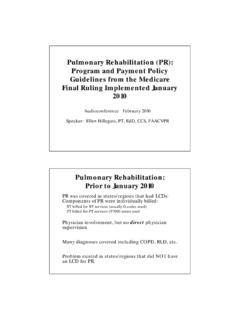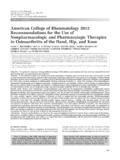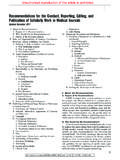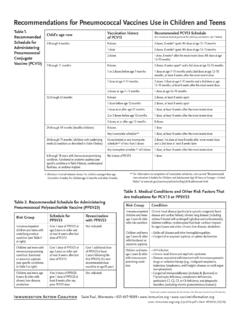Transcription of Oxygen Use: Recommendations For All Practice Settings
1 1/13/20111 Oxygen Use: Recommendations For All Practice SettingsPresented at APTA CSM Feb 10, 2011 ByLarry Cahalin, PT, PhD, CCSR ohini Chandrashekar, PT, CCSR ebecca Crouch, PT, DPT, CCSAnn Fick, PT, DPT, CCSE llen Hillegass, PT, PhD, CCSS usan Butler McNamara, PT, MMSc, CCSAmy Pawlik, PT, DPT, CCSC hristiane Perme, PT, CCSO verview of Presentation Introduction & Overview of Evidence Current Guidelines & Legal Issues of O2 Use Basics of O2 Delivery Pulse Oximetry O2 Delivery Devices Basics of O2 Use and Titration Of Oxygen O2 use in Acute Care O2 use in COPD and with CO2 retention O2 use in Cystic Fibrosis and Heart Failure O2 use in Interstitial Lung Disease (ILD) and Pulmonary Arterial Hypertension (PAH) Summary of RecommendationsObjectives Discuss current evidence of use of Oxygen in Practice including benefits, precautions and populations that benefit from use of Oxygen .
2 Discuss legal issues with use of Oxygen including any limitations in state Practice acts. Define and differentiate the modes of delivery of Oxygen as well as use of pulse oximetry Discuss indications and contraindications for titration of Oxygen and populations that should be used with caution. Identify practical tips with the use of Oxygen in the clinic or when patients travel. Discuss indications for use as well as the similarities and differences of Oxygen use for all populations seen by PTs and PTAs. Summarize Recommendations of O2 use in all clinical Settings based upon current evidence and provide suggestions for further research Why a Task Force on O2 Recommendations ?
3 Therapists from every Practice setting and every state ask CV & P section for information and help on this issue Lack of knowledge of evidence on O2 use in all populations PTs fear legal issues on all aspects of O2 use, especially titration as well as fear with O2 use in COPD and CO2 retainers Lack of knowledge of evidence and guidelines Need exists for PTs to have Recommendations for their professionHypoxemia: What is It? Hypoxemia is defined as a decreased partial pressure of Oxygen (PaO2) less than 60 mm Hg or with an SpO2< 90% Normal ABG values: pH pCO2 35 45 mm Hg PO2 80 100 mm Hg HCO3 22-26 As PaO2 decreases, SpO2 decreasesHypoxemia: Causes & Examples Causes of Decreased PaO2 include: Alveolar hypoventilation Clinical example: atelectasis secondary to post op thoracic or abdominal pain Decreased ventilation (either decreased volume or decreased rate) Clinical example.
4 Decreased volume inability to breathe in adequate volume due to pleural effusion or pulmonary edema Clinical example: decreased rate sedated or comatose causing decreased repiratory rate1/13/20112 Hypoxemia: Causes and Examples Ventilation perfusion mismatching Clinical example: Pulmonary embolus or patient with poor cardiac output Low inspired partial pressure of Oxygen Clinical example: high altitude Impaired diffusion across alveolar-capillary membrane Clinical example: interstitial edema, pulmonary fibrosis impairing diffusion across alveolar wall Shunting Clinical example: Pulmonary embolus, emphysemaHypoxemia: Consequences Hypoxemia has several physiologic consequences: As PaO2 falls below 55 mm Hg.
5 Marked rise in VE (Minute ventilation) with fall in PaCO2 Peripheral vascular beds dilate causing compensatory HR rise (tachycardia) and Cardiac Output increase to increase O2 delivery Regional pulmonary vasoconstriction occurs due to alveolar hypoxia Erythropoietin secretion increases: increase in erythrocytosisand increase in O2 carrying capacityKim 2008 Proc Am Thor SocHypoxemia: Long term effects Polycythemia Pulmonary hypertension Right ventricular failure (corpulmonale) Chronic hypoxemia with corpulmonaleresults in poor prognosis: increased mortality (32-100%) * Cellular changes: Mitochondrial function declines Anaerobic glycolysisoccurs Lactate/pyruvateratio increases* Jones 1967, Boushy 1973 Hypoxemia: Long term Clinical Manifestations Impaired judgment at low levels of hypoxemia Progressive loss of cognitive and motor functions Loss of consciousness with severe hypoxemia Other Headache Breathlessness/ severe dyspnea Palpitations Angina Restlessness TremorManning 1995, Lane 1987, Criner & Celli 1987 Oxygen Use.
6 Short Term and Long TermShort Term Effects of O2 Improves breathlessness with exercise in COPD patients Improves exercise tolerance in those with mild, moderate or severe hypoxemia w/exercise Proposed Mechanisms: Decreased VE (Swinburn 1991 Am Rev Resp Dis) Decrease in dynamic hyperinflation (O Donnell 2001) Alleviation of hypoxic pulmonary vasoconstriction (Dean 1992) Improvement in hemodynamics (Dec PVR, Inc CO) (Dean 1992) Increase in O2 delivery (Morrison 1992) Improvement in ventilatory muscle function (Bye 1985) Altered ventilatory muscle recruitment (Criner & Celli 1987) Reflexive inhibition of central ventilatory drive ( Manning 1995) Decreased perception of dyspnea (Lane 1987)1/13/20113 What are Indications for Short Term Oxygen Therapy?
7 PaO2 < 55 mm Hg or SpO2 < 88% PaO2 55 mm Hg but 59 mm Hg and additional diagnoses (PAH, cor pulmonale) PaO2 60 mm Hg or SpO2 90% but patient desaturates during activity: should use short term O2 with all activitiesKim 2008 Proc Am Thor SocEffect of LTOT Early non-controlled studies: Reduction in mortality in COPD, corpulmonaleand those with severe hypoxemia with use of continuous O2 7-41 mos. Two landmark prospective controlled studies Nocturnal O2 Therapy Trial (NOTT: Ann Intern Med 1980) Continuous O2 versus 12 hrs Nocturnal O2 Mortality was > for nocturnal O2 vs.
8 Continuous O2 British Medical Research Council (MRC) Long Term Domiciliary O2 Therapy Trial (Lancet 1981) Trend that LTOT prevented progressive decrease in PO2 and increase in pulmvascular resistance without increase in PCO2 LTOTC onclusions from 2 studies (population was severely hypoxemic with elevated HCT, elevated PA pressure and Respiratory acidosis Nocturnal O2 is better than NO Oxygen therapy Continuous O2 better than nocturnal O2 therapy No studies have shown benefit with mild or moderate hypoxemia No studies have shown benefit when O2 prescribed for exercise-induced O2 desaturationIndications for Long-Term O2 TherapyKim 2008 Proc Am Thor SocCurrent O2 Guidelines Clinical Practice Guidelines Oxygen Therapy for Adults in the Acute Care Facility 2002 Revision and Update AARC Australian and New Zealand Guidelines for management of COPD 2009 ((Abramson.)))
9 AM Lung Assn 2009)Legal Issues with O2 Use APTA Legislative Department knows of no state that has any limitations on Physical Therapists in use of or titration of Oxygen Oxygen is a DRUG and requires a prescription for its use. Oxygen order should be written based upon SpO2 and not Liters/minute. Always check standing orders or patient s specific orders Desire order to be written: Keep SpO2 90 or 88% Order may be written 2L/min OR SpO2 90 or 88% One State: Connecticut has new changes in their law for use of O2 in hospitals1/13/20114PT State Practice Acts Physical therapy Practice acts and physical therapy board regulations are SILENTon the administration of Oxygen .
10 However, some state/jurisdiction licensing authorities have provided official interpretive opinions/statements on this issue. Check with your state/jurisdiction licensing authority to determine if your state board has an official statement or opinion regarding the administration of Oxygen . To contact your state licensing board, follow this link: APTA Position Statement PHARMACOLOGY IN PHYSICAL THERAPIST Practice HOD P06-04-14-14 (Program 32) [Initial HOD 06-89-43-89] [Medications in the Provision of Physical Therapy] [Position] Physicaltherapistpatient/clientmanagemen tintegratesanunderstandingofapatient s/client sprescriptionand nonprescription medication regimen with consideration of its impact upon health, impairments, functional limitations, and disabilities.










